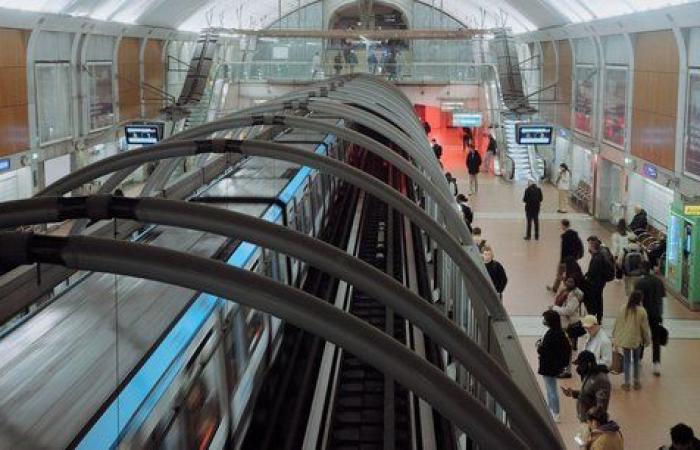For Orly, it is a historic day. The extension of line 14, which connects Saint-Denis to Paris airport, will welcome its first travelers this morning. As Justine Coutard, director of the platform, said during the Paris Air Forum (PAF) 2024, it “ will disrupt the face of Orly which is extremely dependent on the car, it is a huge opportunity to allow modal shift both for passengers and for our employees “. Groupe ADP, which expects to see transit in the new station “ nearly 100,000 passengers per day ».
Extension of line 14: a new takeoff for Orly airport
The 14 « will simplify the journeys of millions of travelers and add a mobility option to our Orly employees » rejoiced Bertrand Godinot, general manager for France of Easyjet, one of the airport’s most important clients, who is launching a summer advertising campaign on the theme of… the metro. He also made no secret during the PAF that his company, which has been present in Orly for more than 20 years, would still like to develop there.
Macron will participate in the inauguration
More broadly, the line will make it possible to reach other emblematic places in the south of Ile-de-France such as the Rungis market, the future Cité de la gastronomy which is due to open in 2028 or the Bièvre scientific valley. It is also and above all a crucial line for the smooth running of the Games since it will serve the athletes’ village, the Stade de France and the aquatic center to the north, unloading lines B and D of the RER and line 13 of the metro. To the south, it will reach Orly airport in 25 minutes from Châtelet, in the center of Paris.
With the extension of line 14, Saint-Ouen opens up a little more to the City of Lights
Like Jacques Chirac in his time during the opening of the first section of the 14, a few months after the 1998 Football World Cup, Emmanuel Macron planned to attend the inauguration, six days before the first round of elections legislative.
« This is a major achievement » for RATP, main project manager of the project, greeted the spokesperson for the public group Jimmy Brun. “ It was ultra-complex, with an extension, a modernization of the operating automation system and the renewal of the rolling stock “, he explains.
The first “supermetro” in the Paris region
With 28 km long, eight new stations and 11 communities crossed, line 14 will transport one million passengers per day by mid-2025, thus becoming the first “supermetro” in the Paris region.
To deliver on time, RATP had to work extra hard. The construction site was almost never interrupted during the Covid-19 pandemic and was able to be completed at the cost of numerous line closures on weekends, during school holidays or in the evening. These ” interruptions de circulation » have often been misunderstood by users, according to Jimmy Brun, increasing the pressure on the teams. Edgar Sée, former director of the project and now “Mr. JO” of the RATP, puts things into perspective: “ Modernizing and extending a line in operation, with so little impact on the service provided, is unique in the world. »
To respond to the foreseeable explosion in attendance, Ile-de-France Mobilités (IDFM) spent 1.1 billion euros to purchase 72 new trains currently being deployed, around fifty of which will be in service by the Olympics . The extension will have cost 3.5 billion euros, entirely financed by the Société des Grands Projets (SGP). The extension will benefit 260,000 inhabitants south of Paris, in Val-de-Marne and Essonne, according to Ile-de-France Mobilités. (IDFM).
A link between the historic network and the future Grand Paris Express network
During a visit at the beginning of June, project director Stéphane Garreau mentioned a “ link between the historic network and the future Grand Paris Express network » thanks to its connections with lines 15, 16, 17 and 18 during the construction phase. The public transport operator Keolis was appointed on Tuesday during the board of directors of Ile-de-France Mobilités (IDFM) as the future operator of line 18 of the Grand Paris Express, which will be put into service gradually between 2026 and 2030 .
It will be opened in three stages: first at the end of 2026 between Massy-Palaiseau and Christ de Salay, then at the end of 2027 with the commissioning of the section between Massy-Palaiseau and Orly and finally, at the end of 2030, between Christ de Saclay and Versailles- Construction site. This automatic metro line will serve ten stations including three elevated stations and will operate like the traditional network, with service starting at 5:00 a.m. and ending at 1:15 a.m., except on Fridays and Saturdays when it will close at 2:15 a.m.
At this stage, only the southern section of line 15, which will open at the end of 2025, will not be operated by Keolis on the future Grand Paris Express lines. RATP Dev, a subsidiary of RATP, was chosen for this 33 km long section which will link Pont de Sèvres to Noisy-Champs. Finally, RATP is also turning its attention to another important program: the automation of line 13, the eternally ill and overloaded network, supposed to be completed in 2035.
(With AFP)






